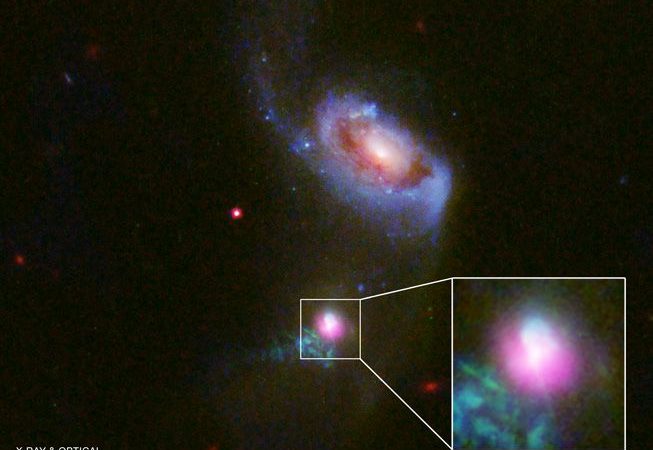It’s not just us humans who get sleepy after big meals. Black holes do, too.
Thanks to data collected by the Chandra X-ray Observatory and the Hubble Space Telescope, astronomers caught a black hole located in a galaxy 800 million light-years away displaying some terrible table etiquette, not once but twice. The black hole gobbled up some stars and gas, “burped” out a flow of high-energy particles and then turned off that flow for 100,000 years before repeating the process all over again.
“We are seeing this object feast, burp and nap, and then feast and burp once again, which theory had predicted,” Julie Comerford of the University of Colorado at Boulder’s Department of Astrophysical and Space Science said in a statement. “Fortunately, we happened to observe this galaxy at a time when we could clearly see evidence for both events.”
Details of Comerford and her team’s study were published in the The Astrophysical Journal and presented Jan. 11 at the meeting of the American Astronomical Society in Washington, D.C.
A spicy two-course meal
Astronomers were studying SDSS J1354+132 (J1354 for short) when the Chandra observatory detected a “bright, point-like source of X-ray emissions” from its center, sure signs of a black hole. These X-ray emissions are the result of gas heated to millions of degrees thanks to the magnetic and gravitational forces of the black hole. The black hole swallows some of this gas while expelling another portion of it in an outflow of particles.
What researchers found when they looked at the optical data was that this supermassive black hole had apparently consumed a large amount of gas, performed the outflow process and then turned it off. Then, 100,000 years later, it ate some more, burped some more and then napped some more. Astronomers are excited by this data because it indicates that black holes can turn their “power output” off and on over and over again.
So how did this black hole get two good meals over 100,000 years? It owes this fine service to a galaxy that collided with J1354 at some point. Now the two galaxies are connected by stars and gas due to that collision. Comerford and her team think that clumped up materials from the companion galaxy ended up drawn to the center of J1354 and were then consumed by the black hole.
The Milky Way galaxy’s black hole likely had its own burp a few million years ago. A 2010 study discovered gamma-ray “bubbles” that extend some 50,000 light-years end-to-end from the center of our galaxy. While these burpy bubbles look different from J1354’s burps, these findings would indicate that our galaxy’s black hole is also taking a little post-meal siesta as well.
“These are the kinds of bubbles we see after a black hole feeding event,” said University of Colorado postdoctoral fellow Scott Barrows. “Our galaxy’s supermassive black hole is now napping after a big meal, just like J1354’s black hole has in the past. So we also expect our massive black hole to feast again, just as J1354’s has.”
Someone get a (very) large bib ready.
Source: Mother Nature Network

































Leave a Comment
You must be logged in to post a comment.